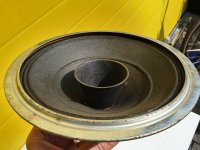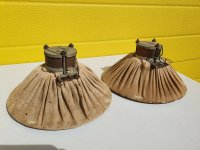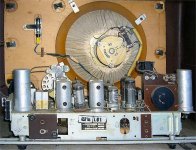Just something that might be interesting and new to some. Not sure if it belongs to the Full Range speaker section. It's a bit unique (or is it?).
In 1957 Philips experimented with a loudspeaker with a voice coil of 4000 Ohm with a centre tap, driven OTL by 2 x UL41 in push-pull. For that they modified their 9754M loudspeaker. They even equiped a number of Philips BX521U radios with this arrangement. These radios are very rare now. I never saw a schematic of it.
In the attached article from 1957 the results were described as rather positive (improved reproduction of the low notes), although only class A operation was possible. But in this Philips book from 1965 it was described as "...not a great success..." beacuse of the coupling between the halves of the voice coil being too loose (see halfway page 15): http://www.introni.it/pdf/Rodenhuis%20-%20HiFi%20Circuits.pdf
The 9754M speakers in pictures 1 and 2 are not of the push-pull kind but just for reference. The 9754M in the third picture is of the push-pull kind.
The purpose of the 'dustcover' is not so much to keep dust out but to dampen of the lower resonance frequency of the speaker (with about 6 dB).
In 1957 Philips experimented with a loudspeaker with a voice coil of 4000 Ohm with a centre tap, driven OTL by 2 x UL41 in push-pull. For that they modified their 9754M loudspeaker. They even equiped a number of Philips BX521U radios with this arrangement. These radios are very rare now. I never saw a schematic of it.
In the attached article from 1957 the results were described as rather positive (improved reproduction of the low notes), although only class A operation was possible. But in this Philips book from 1965 it was described as "...not a great success..." beacuse of the coupling between the halves of the voice coil being too loose (see halfway page 15): http://www.introni.it/pdf/Rodenhuis%20-%20HiFi%20Circuits.pdf
The 9754M speakers in pictures 1 and 2 are not of the push-pull kind but just for reference. The 9754M in the third picture is of the push-pull kind.
The purpose of the 'dustcover' is not so much to keep dust out but to dampen of the lower resonance frequency of the speaker (with about 6 dB).


